Indian Hawthorn
Rhaphiolepis indica
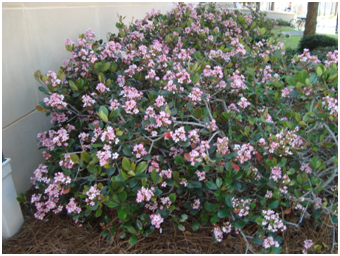
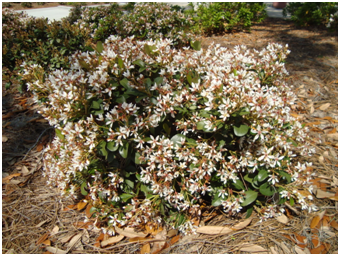
(Photos by Jessica Bartek; Pink variety on left, white variety on right)
View the Location on Campus
Taxonomy (3,5)
Classification: Angiosperm, dicot
Family: Rosaceae
Common name: Indian Hawthorn
Varities on campus: Pink flowered variety (possibly Ballerina), white flowered variety (possibly Clara)
General Information (3,4,5)
Region of Origin: India and southern China
USDA Plants Hardiness Zones: 8-11
Growth Habit: Shrub
- Size: Pink variety: 1-3 feet; White variety: 3-5 feet
- Deciduous/Evergreen: Evergreen
- Flowering: Pink variety: spring, fall, and winter; White variety: mid-April to May
Diagnostic Characteristics
Leaves (1,4,5)
- Arrangement: Alternate
- Simple/Compound: Simple
- Shape: Oblong
- Other: Serrated edges
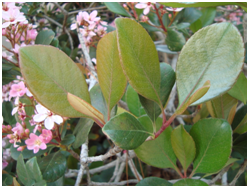
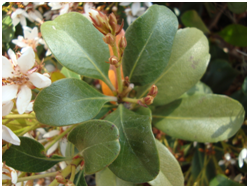
(Photos by Jessica Bartek; Pink variety on left, white variety on right)
Stem/Bark
- Arrangement: Alternate
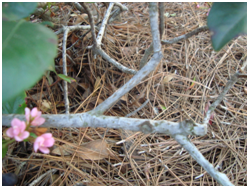
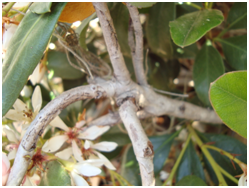
(Photos by Jessica Bartek; Pink variety on left, white variety on right)
Flower (1,5)
- Perfect/Imperfect: N/A
- Color: Pink variety: pink; White variety: white
- Size: 1/2-5/8 inches
- Inflorescence type: Panicle
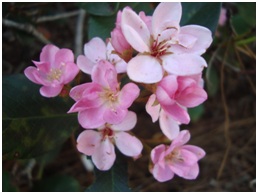
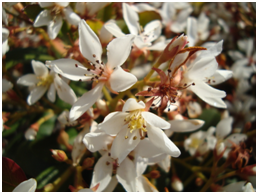
(Photos by Jessica Bartek; Pink variety on left, white variety on right)
Fruit (1,4)
- Fruit type: Pome
- Size: 1/3-3/8 inches
- Color: Blue-black
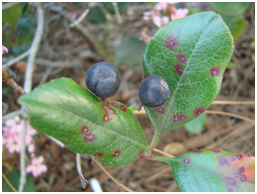
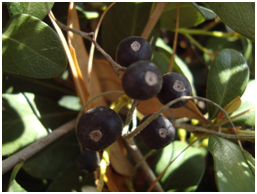
(Photos by Jessica Bartek; Pink variety on left, white variety on right)
Horticultural Information (1,3,4,5)
- Light: Full sun to partial shade
- Soil type: Well-drained
- pH: Neutral
- Maintenance: Easy to care for
- Landscape uses: This is a very common plant used for foundation plantings, hedges, borders, and in highway medians.
- Other: Pruning rarely needed, but best time to prune is in the spring. Fertilize only when new growth starts to appear.
Interesting Facts (1,2,4,5)
- It is salt tolerant.
- Entomosporium is a common disease among this species. It caused by a fungus when there is too much moisture on the leaves. It can be managed by improving air flow by spacing out the plants, using drip irrigation, and pruning.
References
1) Culbert, D. (1998, March 29). Indian hawthorne brings spring flowers. Retrieved from http://okeechobee.ifas.ufl.edu/News columns/Indian.Hawthorne.htm
2) Eaker, T., & Little, E. (n.d.). Entomosporium leaf spot on indian hawthorne. Retrieved from http://www.ugaurbanag.com/landscapealert/entomosporium-leaf-spot-indian-hawthorne
3) Rhaphiolepis indica 'ballerina'. (n.d.). Retrieved from http://www.sonoma.watersavingplants.com/eplant.php?plantnum=543&return=b_aQ
4) Russ, K. (2000, April). Indian hawthorn. Retrieved from http://www.clemson.edu/extension/hgic/plants/landscape/shrubs/hgic1078.html
5) Scheper, J. (1999, April 03). Rhaphiolepis indica. Retrieved from http://www.floridata.com/ref/R/rhap_ind.cfm
Prepared by Jessica Bartek as a course requirement for BIOL 3630/5630, Spring 2013
Department of Biology
-
Room 2035, 2nd Floor
Bailey Science Building -
Mailing Address
1500 N. Patterson St.
Valdosta, GA 31698 - Phone: 229.333.5759
- Fax: 229.245.6585
Monday - Thursday
8:00AM until 5:30PM
Friday
8:00AM until 3:00PM
Saturday - Sunday
Office Closed